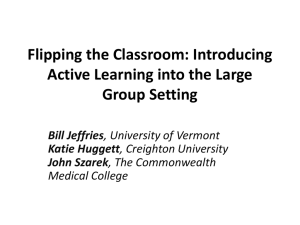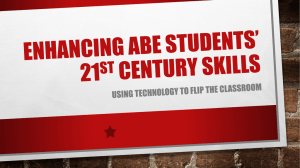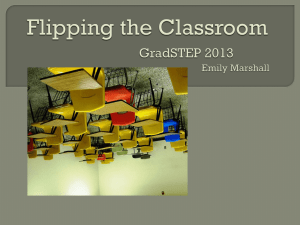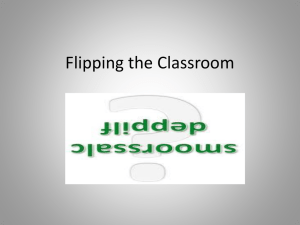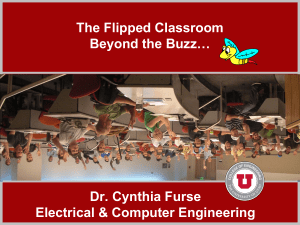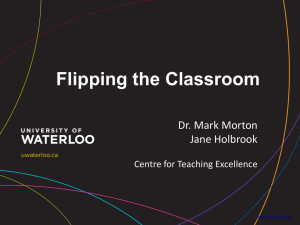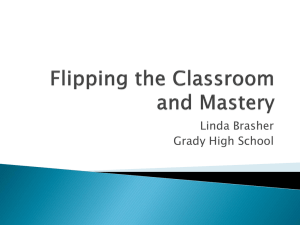Flipping the classroom to enhance student learning
advertisement
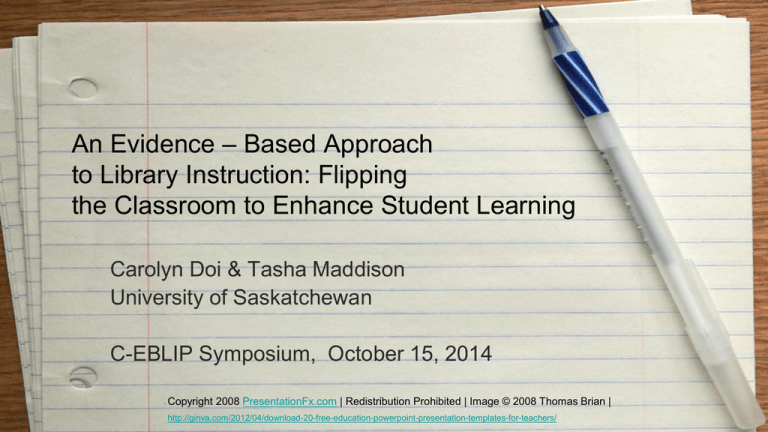
An Evidence – Based Approach to Library Instruction: Flipping the Classroom to Enhance Student Learning Carolyn Doi & Tasha Maddison University of Saskatchewan C-EBLIP Symposium, October 15, 2014 Copyright 2008 PresentationFx.com | Redistribution Prohibited | Image © 2008 Thomas Brian | http://ginva.com/2012/04/download-20-free-education-powerpoint-presentation-templates-for-teachers/ Outline • Research questions • Summary of research literature • Key takeaways from the literature and applicability in two case studies: • Music research methods • Engineering one-shot session EBLIP Steps Step 1: Formulate a Question Step 2: Find the Evidence Step 3: Appraise the Evidence Step 4: Apply the Evidence Step 5: Evaluate the Results Step 6: Disseminate Research “The Steps of EBLIP” http://library.usask.ca/ceblip/eblip/the-steps-of-eblip.php Research Questions • Is the flipped classroom methodology an effective and engaging way to deliver library instruction for undergraduate students at the U of S? • How do we put the teaching methodology into practice? Definition “The flipped classroom has two defining components: moving the lecture outside of class … moving the practical application assignment, formerly homework, into the classroom” (pg. 8) Arnold- Garza, S. (2014). The flipped classroom teaching model and its use for information literacy instruction. Communications in Information Literacy, 8(1), 7-22. Definition “In a flipped classroom much of the instruction takes place outside of class time … Actual class time consists of active learning activities in which students practice and develop what they’ve learned” (pg. 249). Datig, I. & Ruswick, C. (2013). Four quick flips: Activities for the information literacy classroom. C&RL news, 8(1), 249-251,257. Theoretical Framework • Educational technology: "the study and ethical practice of facilitating learning and improving performance by creating, using and managing appropriate technological processes and resources." • Active learning: a process whereby students engage in activities, such as reading, writing, discussion, or problem solving that promote analysis, synthesis, and evaluation of class content. Literature Review • Consulted LIS and education literature • “Flipped classroom” methodology begins to appear in the Education literature (K-12 and Higher Ed.) in 2011 and in the LIS literature in 2013. • “Inverted classroom” methodology begins to appear in Ed. Lit in early 2000s Literature Review • Lage & Platt (2000) • Sams and Bergmann (2008) • Datig & Ruswick (2013) Technology • • • • • Camtasia Jing Lecture Capture Adobe Illuminate / Captivate Guide on the Side Bloom’s Revised Taxonomy Create Evaluate Analyze Apply Understand Remember Anderson, L.W., & Krathwohl. (2001) A Taxonomy for Learning, Teaching and Assessing: A Revision of Bloom’s Taxonomy of Educational Objectives Key elements of flipped teaching 1. Opportunity for students to gain first exposure prior to class 2. Incentive for students to prepare for class 3. Mechanism to assess student understanding 4. In-class activities that focus on higher level cognitive activities Brame, Cynthia. “Flipping the Classroom.” Vanderbilt University Center for Teaching. Music Research Methods • Required course for all music undergraduate students •Introduced teaching material in advance • Discussion to review and conduct informal assessment • Hands-on activity to reinforce and apply learning • Students graded on in-class participation and final assignment Music Research Methods • Video posted on YouTube/Blackboard before class • Assessment posted on Blackboard or at beginning of class • In-class activity tied to learning objectives • Handouts/resources posted on Blackboard Engineering • Target audience: fourth year design classes • Components: – Pre-test for students to establish knowledge and confidence – Instructional Video as homework – In-class review of video – Hands-on activities – Critical evaluation of techniques – Directly tied to curriculum Engineering • GEOE 498 – –13 students, 3.5 months to plan, design, and implement – offered winter 2014 and again in fall of 2014 • CE/ENVE/GEOE 495 – –109 students, 2 weeks – fall 2014 Collaborate “collaborating with faculty is essential to employing the flipped classroom for any course integrated library instruction” (pg. 15). Arnold- Garza, S. (2014). The flipped classroom teaching model and its use for information literacy instruction. Communications in Information Literacy, 8(1), 7-22. Purpose “content is not going to be the thing we do. We’re going to help unpack the content” (pg. 2). Berrett, D. (2012). How ‘flipping the classroom can improve the traditional lecture. The Chronicle of Higher Education, n/a, pp. 6. Retrieved from http://search.proquest.com on March 24, 2014. Context “Flipped classroom teachers almost universally agree that it’s not the instructional videos on their own, but how they are integrated into an overall approach, that makes the difference” (pg. 82). Tucker, B. (2012). The flipped classroom: Online instruction at home frees class time for learning. Education Next, 12(1), 82-83. Effectiveness “online education as effective as classroom instruction, but no better … average of thirty-five percent stronger learning outcomes for students taught in a blended format” (pg. 466). Lemmer, C.A. (2013). A view from the flip side: Using the “inverted classroom” to enhance the legal information literacy of the international LL.M. student. Law Library Journal, 105(4), 461-491. Thank you! • Carolyn Doi carolyn.doi@usask.ca • Tasha Maddison tasha.maddison@usask.ca @tmmaddison Bibliography – Library Literature Arnold-Garza, S. (2014). The flipped classroom: Assessing an innovative teaching model for effective and engaging library instruction. C&RL News, 75(1), 10-13. Jaguszewski, Janice & Williams, K. (2013). New roles for new times: transforming liaison roles in research libraries. Arnold-Garza, S. (2014). The flipped classroom teaching model and its use for information literacy instruction. Communications in Information Literacy, 8(1), 7-22. Rivero, V. (2013). ”Flipping out: A new model to reach all students all ways.” Internet@Schools, 20(1), 14-16. Bayliss, S. (2013). Flip it now. School Library Journal, 59(11), 1. Roehl, A., Reddy, S.L., & Shannon, G.J. (2013). ”The flipped classroom: An opportunity to engage millennial students through active learning strategies.” Journal of Family and Consumer Sciences, 105(2), 44-49. Becker, B.W. (2013). Start flipping out with the guide on the side. Behavioral & Social Sciences Librarian, 32(4), 257-260. Berrett, D. (2012). How 'flipping' the classroom can improve the traditional lecture. The Chronicle of Higher Education, Retrieved from http://search.proquest.com/docview/922583343?accountid=14739 Brame, C., (2013). Flipping the classroom. Vanderbilt University Center for Teaching. http://cft.vanderbilt.edu/guides-sub-pages/flipping-the-classroom/. Bull, G., Ferster, B., & Kjellstrom, W. (2012). Inventing the flipped classroom. Learning & Leading with Technology, 40(1), 10. Datig, I., & Ruswick, C. (2013). Four quick flips: Activities for the information literacy classroom. College & Research Libraries News, 74(5), 249-257. Ebbeler, J. (2013). ‘Introduction to ancient Rome’, the flipped version. The Chronicle of Higher Education, 59(43). Kim, M.K., Kim, S.M., Khera, O. & Getman, J. (2014). The experience of three flipped classrooms in an urban university: An exploration of design principles. Internet and Higher Education, 22, 37-50. Lemmer, C.A. (2013). A view from the flip side: Using the “inverted classroom” to enhance the legal information literacy of the international LL.M. student. Law Library Journal, 105(4), 461-491. Sales, N. (2013). Flipping the classroom: Revolutionising legal research training. Legal Information Management, 13, 231-235. Tucker, Bill. (2012). “The Flipped Classroom: Online instruction at home frees class time for learning.” Education Next. educationnext.org/files/ednext_20121_BTucker.pdf Valenza, Joyce Kasman. (2012). “The Flipping Librarian.” Voya Magazine. http://www.voyamagazine.com/2012/09/21/tag-team-tech-october-2012/ Zappe, S., Leicht, R., Messner, J., Litzinger, T., & Lee, H. (2009). Flipping the classroom to explore active learning in a large undergraduate course. Proceedings of the 2009 American Society of Engineering Education Annual Conference and Exhibition. Bibliography – Education Literature Arnold-Garza, S. (2014). The flipped classroom: Assessing an innovative teaching model for effective and engaging library instruction. C&RL News, 75(1), 10-13. Jaguszewski, Janice & Williams, K. (2013). New roles for new times: transforming liaison roles in research libraries. Arnold-Garza, S. (2014). The flipped classroom teaching model and its use for information literacy instruction. Communications in Information Literacy, 8(1), 7-22. Rivero, V. (2013). ”Flipping out: A new model to reach all students all ways.” Internet@Schools, 20(1), 14-16. Bayliss, S. (2013). Flip it now. School Library Journal, 59(11), 1. Roehl, A., Reddy, S.L., & Shannon, G.J. (2013). ”The flipped classroom: An opportunity to engage millennial students through active learning strategies.” Journal of Family and Consumer Sciences, 105(2), 44-49. Becker, B.W. (2013). Start flipping out with the guide on the side. Behavioral & Social Sciences Librarian, 32(4), 257-260. Berrett, D. (2012). How 'flipping' the classroom can improve the traditional lecture. The Chronicle of Higher Education, Retrieved from http://search.proquest.com/docview/922583343?accountid=14739 Brame, C., (2013). Flipping the classroom. Vanderbilt University Center for Teaching. http://cft.vanderbilt.edu/guides-sub-pages/flipping-the-classroom/. Bull, G., Ferster, B., & Kjellstrom, W. (2012). Inventing the flipped classroom. Learning & Leading with Technology, 40(1), 10. Datig, I., & Ruswick, C. (2013). Four quick flips: Activities for the information literacy classroom. College & Research Libraries News, 74(5), 249-257. Ebbeler, J. (2013). ‘Introduction to ancient Rome’, the flipped version. The Chronicle of Higher Education, 59(43). Kim, M.K., Kim, S.M., Khera, O. & Getman, J. (2014). The experience of three flipped classrooms in an urban university: An exploration of design principles. Internet and Higher Education, 22, 37-50. Lemmer, C.A. (2013). A view from the flip side: Using the “inverted classroom” to enhance the legal information literacy of the international LL.M. student. Law Library Journal, 105(4), 461-491. Sales, N. (2013). Flipping the classroom: Revolutionising legal research training. Legal Information Management, 13, 231-235. Tucker, Bill. (2012). “The Flipped Classroom: Online instruction at home frees class time for learning.” Education Next. educationnext.org/files/ednext_20121_BTucker.pdf Valenza, Joyce Kasman. (2012). “The Flipping Librarian.” Voya Magazine. http://www.voyamagazine.com/2012/09/21/tag-team-tech-october-2012/ Zappe, S., Leicht, R., Messner, J., Litzinger, T., & Lee, H. (2009). Flipping the classroom to explore active learning in a large undergraduate course. Proceedings of the 2009 American Society of Engineering Education Annual Conference and Exhibition.
